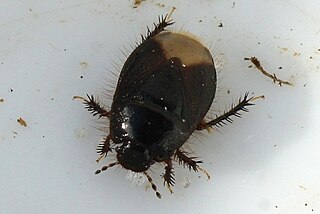
Pentatomidae is a family of insects belonging to the order Hemiptera, generally called shield bugs or stink bugs. Pentatomidae is the largest family in the superfamily Pentatomoidea, and contains around 900 genera and over 4700 species. As hemipterans, the pentatomids have piercing sucking mouthparts, and most are phytophagous, including several species which are severe pests on agricultural crops. However, some species, particularly in the subfamily Asopinae, are predatory and may be considered beneficial.

Bandwings, or band-winged grasshoppers, are the subfamily Oedipodinae of grasshoppers classified under the family Acrididae. They have a worldwide distribution and were originally elevated to full family status as the Oedipodidae. Many species primarily inhabit xeric weedy fields, and some are considered to be important locusts:

Delphacidae is a family of planthoppers containing about 2000 species, distributed worldwide. Delphacids are separated from other "hoppers" by the prominent spur on the tibia of the hindleg.

Dictyopharidae is a family of planthoppers, related to the Fulgoridae. The family comprises nearly 760 species in more than 150 genera which are grouped into two subfamilies, Dictyopharinae and Orgeriinae.

Cicadetta is a genus of generally small-bodied annual cicadas widespread across portions of the Palearctic, Indomalayan, and Afrotropical realms. In older scientific and taxonomic literature, this genus was popularly referred to as Melampsalta. These cicadas occur in a diverse spectrum of habitats, although most taxa are typically associated with weedy meadows and tallgrass prairie ecosystems. Several related species from North America were recently transferred to the genus Cicadettana.

Phylinae is a subfamily of the plant bug family Miridae. Species of this family are found worldwide.

Tytthus is a genus of insects in family Miridae, the plant bugs. They are carnivorous, feeding upon the eggs of various planthoppers in the family Delphacidae, and thus are important in the biological control of pests. The genus is distributed throughout the Holarctic of the Northern Hemisphere, but species are also found in the tropics, in China, South America, Australia, and the Indo-Pacific.

Phylini is a tribe of plant bugs in the family Miridae, based on the type genus Phylus. There are at least 440 described species in Phylini.

Zygina is a genus of leafhoppers, belonging to the family Cicadellidae.
Euides is a genus of planthoppers belonging to the family Delphacidae.
Conomelus is a genus of true bugs belonging to the family Delphacidae.
Delphacinus is a genus of true bugs belonging to the family Delphacidae.

Kybos is a genus of true bugs belonging to the family Cicadellidae.
Dicranotropis is a genus of true bugs belonging to the family Delphacidae.
Eurysula is a genus of true bugs belonging to the family Delphacidae.
Ribautodelphax is a genus of true bugs belonging to the family Delphacidae.
Stiroma is a genus of true bugs belonging to the family Delphacidae.
Achorotile is a genus of true bugs belonging to the family Delphacidae.

Byrsinus is a genus of burrowing bugs in the tribe Geotomini, erected by Franz Xaver Fieber in 1860. The species Byrsinus flavicornis is recorded from northern Europe including the British Isles.










